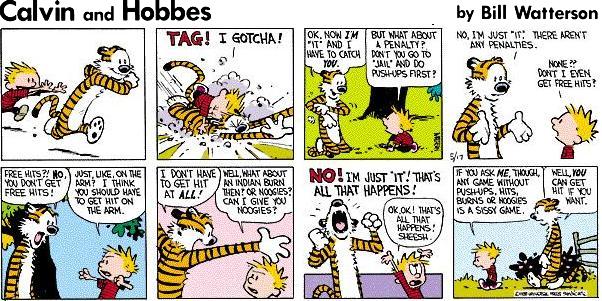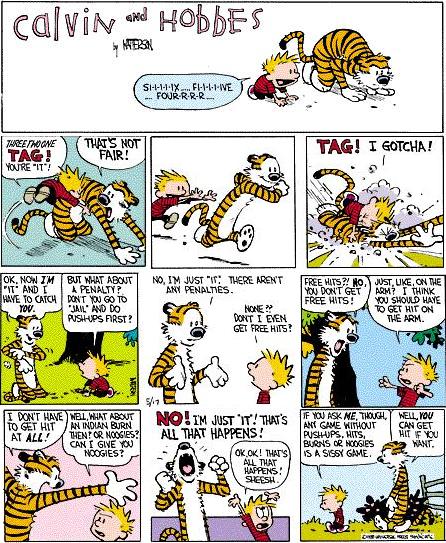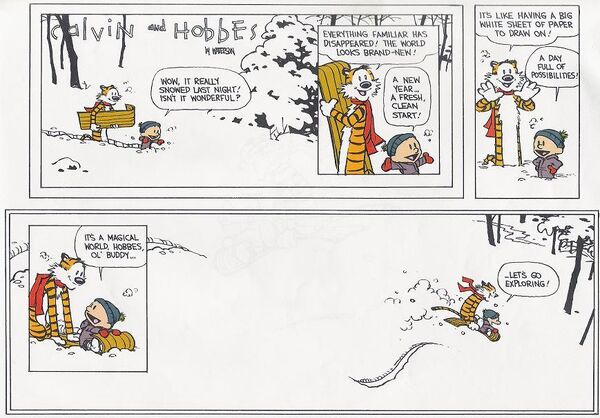m (Reverted edits by CalvinTheGreat11 (talk | block) to last version by Serpinium) |
No edit summary |
||
| Line 2: | Line 2: | ||
In ''[[Calvin and Hobbes]]'', Sunday comics often feature more outlandish scenarios than the weekday strips, and are less reliant on punchlines and gags than the expression of artistic license. For instance, longer poems are mostly featured in Sunday strips, and some Sundays are completely dialogue-free. This is consistent with [[Bill Watterson]]'s insistence that syndicated comics should be treated as a serious art form as opposed to vapid, pandering commercial hackwork. |
In ''[[Calvin and Hobbes]]'', Sunday comics often feature more outlandish scenarios than the weekday strips, and are less reliant on punchlines and gags than the expression of artistic license. For instance, longer poems are mostly featured in Sunday strips, and some Sundays are completely dialogue-free. This is consistent with [[Bill Watterson]]'s insistence that syndicated comics should be treated as a serious art form as opposed to vapid, pandering commercial hackwork. |
||
| + | |||
| + | Only three Sunday strips in the entire comic's run are part of any ongoing story arcs at the time. This is because the Sunday Strips require a longer lead time than the dailies to allow for color, and to include a Sunday strip in a story, the entire story must be written that far in advance. |
||
In the strip's later years, particularly starting with the first [[Sabbatical|sabbatical]] and subsequent change in [[Sunday Formatting|format]], Sunday comics upstaged [[Story arcs|story arcs]] somewhat. As the latter dwindled in frequency, the focus on Sunday strips became narrowe: for instance, [[Spaceman Spiff]]'s appearances were relegated almost exclusively to the larger Sunday format from 1991 onward. Moreover, the comparatively stiff, restrictive structure of the earlier Sunday strips was dropped in order to make way for more unorthodox layouts. |
In the strip's later years, particularly starting with the first [[Sabbatical|sabbatical]] and subsequent change in [[Sunday Formatting|format]], Sunday comics upstaged [[Story arcs|story arcs]] somewhat. As the latter dwindled in frequency, the focus on Sunday strips became narrowe: for instance, [[Spaceman Spiff]]'s appearances were relegated almost exclusively to the larger Sunday format from 1991 onward. Moreover, the comparatively stiff, restrictive structure of the earlier Sunday strips was dropped in order to make way for more unorthodox layouts. |
||
Revision as of 19:23, 8 February 2014
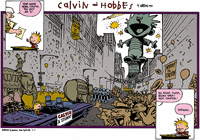
A later-year Calvin & Hobbes Sunday strip. Notice the detail and liberal use of space.
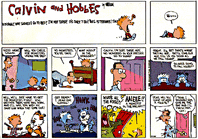
11/24/85: The first Calvin and Hobbes Sunday comic. Notice the sparse artwork and rigid layout.
Sunday comics, featured in the thicker Sunday newspapers, have more room, permit the use of color and lack the rigidity of their weekday and Saturday counterparts. Bill Watterson insists on taking advantage of all available space, but has been known to forgo or restrict the use of color in Sunday comics.
In Calvin and Hobbes, Sunday comics often feature more outlandish scenarios than the weekday strips, and are less reliant on punchlines and gags than the expression of artistic license. For instance, longer poems are mostly featured in Sunday strips, and some Sundays are completely dialogue-free. This is consistent with Bill Watterson's insistence that syndicated comics should be treated as a serious art form as opposed to vapid, pandering commercial hackwork.
Only three Sunday strips in the entire comic's run are part of any ongoing story arcs at the time. This is because the Sunday Strips require a longer lead time than the dailies to allow for color, and to include a Sunday strip in a story, the entire story must be written that far in advance.
In the strip's later years, particularly starting with the first sabbatical and subsequent change in format, Sunday comics upstaged story arcs somewhat. As the latter dwindled in frequency, the focus on Sunday strips became narrowe: for instance, Spaceman Spiff's appearances were relegated almost exclusively to the larger Sunday format from 1991 onward. Moreover, the comparatively stiff, restrictive structure of the earlier Sunday strips was dropped in order to make way for more unorthodox layouts.
Formatting
The standard Sunday format is a rearrangeable structure for Sunday comics used by Bill Watterson before he switched to the newer style, following the first sabbatical, in February 1992. The standard styles can go as follows (sampled strip from 6/26/1988):
Above is the original strip that takes up 1/2 of the newspaper comic page. This method can be altered, as shown below.
Above is the "edited" version of the comic that gets rid of the "throwaway joke" at the top. This only takes up 1/3 of the comic strip page.
Above is the 1/4 style that takes up 1/4 of the newspaper page. It shows the entire strip, but in a different way.
Above is Calvin and Hobbes in yet another format. When Sunday comics were refitted for the earlier book collections (predating the formatchange), they would be refitted so they could be placed vertically, as opposed to horizontally like in the newspapers.
Above is the 1992-revised, unbreakable 1/2 page Sunday format. Its structure can not be refitted on account of alloted space, and so preserves the integrity of the strip.
It is worth noting that the pre-sabbatical strips can be displayed with:
- The title, throwaway joke, and content.
- The title and content.
- Simply the content.


